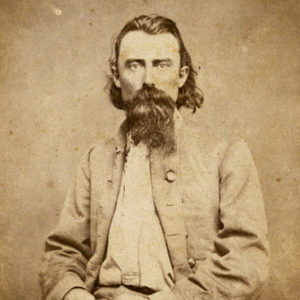calsfoundation@cals.org
Action at Ashley's Station
aka: Action at Jones' Station
aka: Action at DeValls Bluff
| Location: | Prairie and Lonoke counties |
| Campaign: | None |
| Date: | August 24, 1864 |
| Principal Commanders: | Colonel Greenville M. Mitchell (US); Brigadier General Joseph O. Shelby (CS) |
| Forces Engaged: | Fifty-fourth Illinois Infantry Regiment, First Nebraska Cavalry |
| Regiment (detachment) (US); Shelby’s Confederate Cavalry (CS) | |
| Estimated Casualties: | 977 (US); 173 (CS) |
| Result: | Confederate victory |
The Action at Ashley’s Station was Confederate Brigadier General Joseph O. Shelby’s attack on Union hay-cutting operations west of DeValls Bluff (Prairie County) and the final action of a summer of Confederate raiding against Union targets in northeast Arkansas.
In the summer of 1864, DeValls Bluff was a major depot for Federal cavalry stationed along the White River. Union authorities contracted with civilian hay cutters to operate in the Grand Prairie west of the White River stronghold and supply fodder for its thousands of horses and mules. On August 20, 1864, Shelby set out from camps around Searcy (White County) with 2,000 to 2,500 men to strike the railroad from Memphis, Tennessee, to Little Rock (Pulaski County), believing he would link up with Major General Sterling Price, who was planning a raid into Missouri.
A series of five forts housed Federal troops guarding the hay-cutting operations along the railroad between Brownsville (Prairie County) and DeValls Bluff. The Fifty-fourth Illinois Infantry Regiment and detachments of the First Nebraska Cavalry Regiment were manning the five forts when Shelby’s troops approached from the north on the morning of August 24. Shelby’s veteran horsemen were almost exclusively dressed in captured Union uniforms as they approached the unsuspecting Union troops and civilian contractors at the westernmost forts at Ashley’s Station.
The Confederate attackers swiftly captured three forts as Colonel Greenville M. Mitchell, commander of the Fifty-fourth Illinois, gathered his six surviving companies in a fourth fort and prepared to hold off Shelby’s assault. Mitchell sent a desperate message to DeValls Bluff requesting reinforcements as Shelby’s artillery began shelling the fort. Brigadier General Christopher Columbus Andrews, commanding at DeValls Bluff, quickly sent a relief force of 890 men under Colonel Washington F. Geiger toward the endangered forts. Mitchell and his men saw the approaching Union cavalrymen and rushed from the fort toward the relief column but were quickly captured and hurried north by Shelby’s men.
Geiger’s troops engaged with a detachment Shelby had deployed between the hay stations and DeValls Bluff. A two-hour action ensued in which the Confederates were forced back slowly even as the main Rebel force burned hay machines and destroyed a large section of the railroad. Geiger broke off the action as night approached, reporting nine of his men killed, forty-three wounded, and one missing. The Confederate force left the field as other Union forces approached from the west, fighting a delaying action at Big Cypress Creek before returning to their camps on the White River.
Shelby suffered 173 killed and wounded in his attack on the hay-cutting operations. He claimed that his troops captured 577 Union troops and killed or wounded 200 more; Andrews acknowledged 400 to 500 captured in addition to Geiger’s casualties. In addition, Shelby claimed that his cavalrymen destroyed ten miles of railroad track, burned 3,000 bales of hay and twenty hay-cutting machines, razed the five Union forts, and captured many horses and small arms. The attacks along the railroad were Shelby’s final significant operations north of the Arkansas River that summer.
For additional information:
Christ, Mark K. “Ashley and Jones Stations Battlefield.” Arkansas Register of Historic Places Registration Form. On file at Arkansas Historic Preservation Program, Little Rock, Arkansas. Online at http://www.arkansaspreservation.com/arkansas-register-listings/ashley-39-s-and-jones-39-station-battlefield (accessed March 20, 2019).
———. “The Queen City was a Helpless Wreck.” In “The Earth Reeled and Trees Trembled”: Civil War Arkansas 1863–1864, edited by Mark K. Christ. Little Rock: Old State House Museum, 2007.
“‘Sun stroke & tired out’: Chasing J. O. Shelby, June 1864.” Arkansas Historical Quarterly 68 (Summer 2009): 201–212.
Edwards, John N. Shelby and his Men: or, the War in the West. Waverly, MO: General Joseph Shelby Memorial Fund, 1993.
Porter, Scott A. “Thunder across the Arkansas Prairie: Shelby’s Opening Salvo in the 1864 Invasion of Missouri.” Arkansas Historical Quarterly 66 (Spring 2007): 43–56.
Potter, James E. “The First Nebraska’s Orphan Detachment and the Skirmish at Grand Prairie, 1864.” Nebraska History 81.1 (2000): 35–39.
The War of the Rebellion: A Compilation of the Official Records of the Union and Confederate Armies. Series 1, Vol. 41. Washington DC: Government Printing Office, 1890–1901, p. 280–288.
Mark K. Christ
Arkansas Historic Preservation Program
 Joseph Shelby
Joseph Shelby 




Comments
No comments on this entry yet.